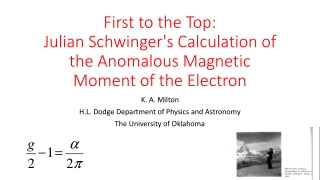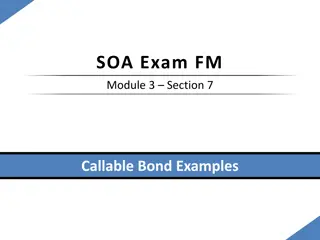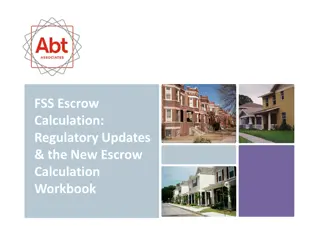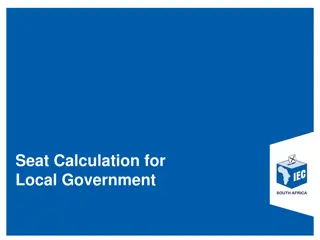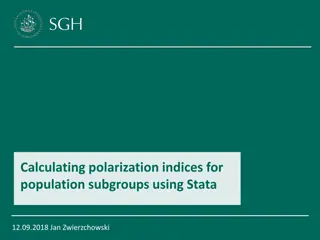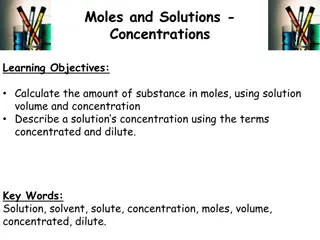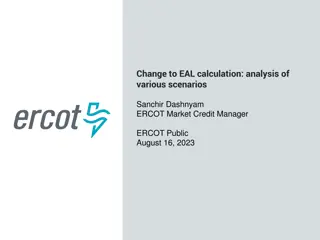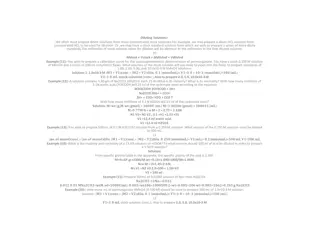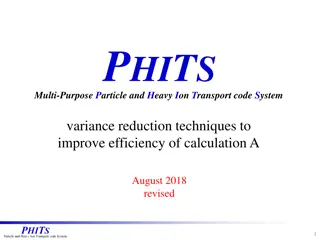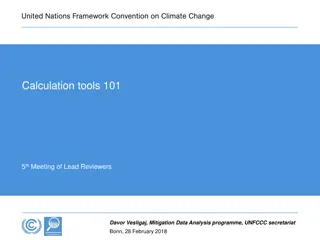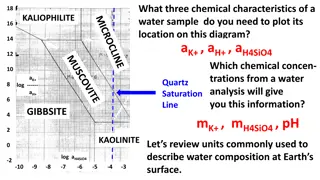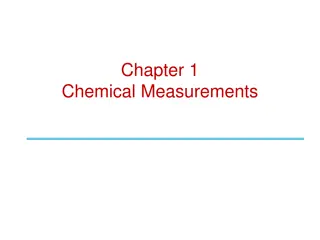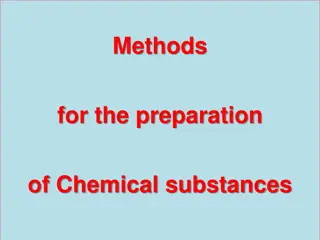Unveiling Julian Schwinger's Electromagnetic Calculation
Discover the groundbreaking calculation by physicist Julian Schwinger on the electron's anomalous magnetic moment. Gain insights into this pivotal contribution in physics research that impacts our understanding of the electron's behavior. This work sheds light on Schwinger's innovative approach and
1 views • 33 slides
Power System Fault Calculation and Protection Analysis
In this technical document, we delve into the calculation of fault current and fault apparent power in symmetrical three-phase short circuit scenarios within power systems. Through detailed equivalent circuit diagrams, reactance calculations, and per unit value derivations, the fault current and app
5 views • 15 slides
Maximum Price Calculation for Callable Bond with Annual Yield Requirement
A 20-year callable bond example is provided with a $1000 face value and 3% annual coupons, callable at different redemption values over specific years. The task is to determine the maximum price a buyer should pay to achieve a minimum annual yield of 5%. The calculation involves identifying the time
0 views • 33 slides
Understanding Student Loans: Options, Interest Calculation, Daily Interest Formula
Explore the various options available for student loans, learn how to calculate interest in different loan scenarios, and apply the simplified daily interest formula. Discover key terms like FAFSA, EFC, federal loans, private loans, and more. Dive into examples of interest accrual during school and
0 views • 19 slides
FSS Escrow Calculation and Regulatory Updates Summary
Comprehensive overview of the new escrow calculation workbook, regulatory updates, and changes to the Final Rule for FSS escrow calculation. Key topics include FSS terminology, calculation examples, and important points for locally generated housing funds. The Final Rule changes include uncapped esc
4 views • 9 slides
Electrical Conductor Ampacity Calculation Scenarios
Various scenarios are presented involving the calculation of allowable ampacity for different types of electrical conductors connected to circuit breakers with temperature limitations. The calculations consider factors like conductor material, size, temperature ratings, and ambient conditions to det
0 views • 140 slides
Mushroom Production Profit Calculation and Business Models
Explore the profit calculation and business models for Paddy Straw Mushroom and Oyster Mushroom production. Learn about the capital investments needed, economics of production per bed, and potential profits. Discover the cost breakdown and quantities required for setting up a mushroom production bus
1 views • 5 slides
Understanding Bitmap Image Data Representation and File Size Calculation
This content delves into the fundamentals of bitmap images, covering topics such as resolution, color depth, file size calculation, and metadata. Explore how different parameters affect the quality and size of images, with practical examples and activities to enhance learning.
0 views • 18 slides
Fire Flow Requirements and Calculation Methods
Detailed information on site fire flow and hydrant flow testing requirements, how to calculate required fire flow, applicable codes and standards including NFPA and IBC, duration of fire flow, methodologies for fire flow calculation, and ISO methods and formulas.
4 views • 30 slides
Understanding the Rank of a Matrix and Calculation Methods
The rank of a matrix is crucial in linear algebra, indicating the number of linearly independent rows or columns. Learn about the concept, calculation methods like minor method and echelon form, and practical examples in this informative guide.
3 views • 12 slides
Local Government Seat Calculation Framework
The legislative framework in South Africa outlines the seat calculation process for local government elections, emphasizing proportional representation. It involves determining quotas for proportionality, allocating seats based on total party votes, and addressing scenarios where parties may have mo
0 views • 8 slides
Understanding FTES Calculation in California Community Colleges
California Community Colleges use Full-Time Equivalent Students (FTES) to allocate apportionment revenue based on student attendance. FTES calculation involves factors like clock hours, class hours, passing time/breaks, and multiple-hour classes. Understanding these components is essential for educa
0 views • 35 slides
Anesthesia Billing & Reimbursement Basics
Understanding the essentials of anesthesia billing for surgical procedures is crucial for healthcare providers. This guide covers the key aspects such as the three fees generated by each procedure, calculation of total units, base units, time units, and the anesthesia fee calculation process. Knowin
4 views • 29 slides
Understanding Economic Polarization and Polarization Indices
Explanation of the concept of economic polarization and the calculation of polarization indices for population subgroups using Stata. Discusses the disappearance of the middle income class, misuse of the term economic polarization, and measures like the median relative polarization index (MRP) for a
2 views • 15 slides
Understanding the Capital Asset Pricing Model (CAPM) for Required Return Calculation
Learn about the Capital Asset Pricing Model (CAPM) and how to calculate the required return on an investment using this model. Explore key concepts such as stock return, market return, beta calculation, and more with a practical example involving Riyad Bank and Tadawul All Shares Index. Utilize dail
1 views • 35 slides
Understanding Solutions and Concentration Units
Explore the world of solutions, the role of solvents and solutes, why solutions form, different concentration units like molarity and molality, calculations involved, colligative properties such as vapor pressure lowering, and how Raoult's Law explains changes in boiling and freezing points in solut
0 views • 13 slides
Mastering Excel Formulas and Functions for Efficient Data Calculation
Delve into the essentials of Excel formulas and functions to streamline your data calculation tasks effectively. Learn about the components of formulas, order of operations, popular functions like SUM, COUNT, and AVERAGE, and how to create, copy, and apply themes to your calculations. Discover the p
0 views • 9 slides
Understanding Concentration in Solutions
Solutions involve the dissolution of solutes like salt or sugar in solvents such as water, resulting in different concentrations. This concentration can be expressed as moles per liter, known as molarity. By calculating the amount of substance in moles using solution volume and concentration, you ca
0 views • 8 slides
Analysis of Change in EAL Calculation Scenarios
In this analysis, Sanchir Dashnyam, the ERCOT Market Credit Manager, discusses the change in the EAL calculation formula, exploring different scenarios and their impacts on ERCOT markets. The scenarios involve adjustments to the application of RFAF against various parameters, aiming to optimize the
0 views • 7 slides
Diluting Solutions in Chemistry
Diluting solutions is a common practice in chemistry to prepare solutions of different concentrations for various experiments and analyses. This involves diluting stock solutions to desired concentrations using the formula M1V1 = M2V2. The process includes preparing calibration curves, determining m
0 views • 6 slides
Preparation of Solution from Solid: Practical General Chemistry Techniques
Solutions are homogeneous mixtures where a solute is dissolved in a solvent. Known concentration solutions can be prepared using solid substances through careful techniques. This process involves weighing the solid, dissolving it in a beaker, transferring to a volumetric flask, and finalizing the so
0 views • 12 slides
Back-End Ocean Data Analysis Program for LCS Calculation
A program designed to automatically retrieve ocean data over an eight-day period and compute Lagrangian Coherent Structures (LCS) on a daily basis. The generated data can then be plotted to visualize the LCS patterns in the ocean. Motivated by guiding fluid flows, the program can aid in predicting t
0 views • 11 slides
Efficiency Enhancement in PHITS: Variance Reduction Techniques for Particle and Heavy Ion Transport
Explore techniques for improving calculation efficiency in the PHITS Multi-Purpose Particle and Heavy Ion Transport code system. Topics covered include neutron deep penetration calculation, effective dose calculation, and use of variance reduction techniques to enhance Monte Carlo simulation efficie
0 views • 24 slides
Overview of Calculation Tools for Mitigation Data Analysis Program under UNFCCC Secretariat
This content discusses various calculation tools used in the Mitigation Data Analysis program of the UNFCCC Secretariat. It includes tools for GHG projections, financial support, and their integration into Country briefs to facilitate accurate data presentation and reduce workload during reviews. De
0 views • 7 slides
Understanding Solution Concentration in Chemistry
Solutions in chemistry are homogeneous mixtures of two or more substances where each maintains its own chemical identity. They consist of a solute, the substance being dissolved, and a solvent, the substance used to dissolve the solute. Solution concentration can be described qualitatively as concen
0 views • 17 slides
Understanding Solution Composition in Chemistry
Exploring the properties of solutions, this content delves into measuring solution composition using techniques like molarity, mass percent, and mole fraction. Through examples, it explains how to calculate the weight percent of solutes in solutions, offering a comprehensive guide on understanding e
0 views • 66 slides
Understanding Solution Concentration and pH Calculations
Explore the concepts of solution concentration, specifically molarity calculations, and pH measurements related to the power of the Hydronium ion. Learn how to calculate molarity, determine the Hydrogen/Hydronium ion concentration, and understand the pH scale from acidic to basic. Practice sample pr
0 views • 13 slides
Chemistry Class Announcements and Demonstrations
Chemistry class announcements include details about an upcoming exam, homework deadlines, and lab submissions. Additionally, demonstrations on solution molarity and concentration are provided to help students understand key concepts. The content also touches on the Flint, Michigan water crisis, illu
0 views • 11 slides
Understanding Income Tax Calculation and Salary Calculation
This educational content covers various aspects of income tax calculation, including taxable rates, personal allowances, and calculations for different salary levels. It explains how to determine weekly, monthly, and annual salaries and provides examples of income tax calculations for different inco
0 views • 23 slides
Acid-Base Titration Lab Procedure & Calculations
Conduct an acid-base titration experiment to determine the molarity of an unknown NaOH solution using HCl as the titrant. Follow the outlined steps, record data, perform calculations, and analyze the results to understand the principles of this chemical reaction. Learn about indicators, mole ratios,
0 views • 7 slides
Understanding Solubility Product Constant for Slightly Soluble Salts
Solubility product constant (Ksp) is a special constant that describes the solubility of slightly soluble salts like potassium acid tartrate (KHT) and silver chloride (AgCl) in solution. This experiment aims to determine Ksp for KHT and explore factors affecting Ksp such as temperature and common io
0 views • 13 slides
Understanding Inflation and CPI Calculation
Learn about inflation and the Consumer Price Index (CPI) calculation process. Inflation is the rise in the overall price level in an economy, impacting the cost of living. CPI measures the cost of goods and services purchased by an average consumer to track changes in the cost of living over time. T
0 views • 39 slides
Understanding Chemical Characteristics and Units in Water Composition Analysis
Discover the essential chemical characteristics required to plot a water sample on a diagram and learn about the limitations of using molarity for concentrated solutions of divalent ions, especially when dealing with changing temperatures. Explore the concept of molality and its advantages, while al
0 views • 13 slides
Understanding Molarity and Molality in Solutions
Solutions are combinations of solvent and solute, with varying concentrations affecting their properties. Molarity and molality are key measures of concentration, and saturation levels impact solubility. Explore examples to calculate molarity for solutions in different scenarios.
0 views • 12 slides
Chemical Measurements Overview
In Chapter 1 - Chemical Measurements, you will delve into SI Units, derived SI units, prefixes, unit conversions, concentrations like molarity and molality, and percent compositions. Explore how to use prefixes for calculations, convert units, and understand different concentration measurements for
0 views • 22 slides
Understanding Concentration and Dilution of Solutions by Dr. Laila Al-Harbi
Dr. Laila Al-Harbi explains the concept of concentration of solutions, focusing on molarity and the calculation involved. The molar concentration of solutions is determined by the amount of solute in a given volume of solvent, expressed as moles of solute per liter of solution. Additionally, the pro
0 views • 15 slides
Chemistry Study Materials and Practice Questions
This collection of chemistry study materials includes information on reactions, solubility, electrolytes, and solution stoichiometry. Practice questions cover classifying solutes, predicting solubility of salts, writing ions produced in water, and determining precipitates in reactions. Includes a mo
0 views • 15 slides
Understanding Solution Concentration: Lesson in Chemistry
Explore the concept of solution concentration through an engaging experiment involving gummy bears in sugar and water solutions. Learn about key terms such as solution, solute, solvent, saturated solution, concentration, and molarity. Discover how molecules move based on concentration gradients and
0 views • 10 slides
Understanding Solutions and Concentration in Chemistry
Explore the concepts of solutions, solutes, solvents, concentration, and molarity through engaging activities like the "Bearly Alive" experiment and discussions on saturated solutions. Learn to define and calculate molarity, and understand how compounds behave in solution. Get ready for hands-on lab
0 views • 13 slides
Chemical Substances Preparation Methods
Methods for preparing chemical substances including calculations for molarity, preparation of solutions from solid and liquid substances, and examples for preparing specific solutions like BaCl2 and CuSO4. Explained techniques for calculating the amount of solid substances needed to achieve a desire
0 views • 8 slides
